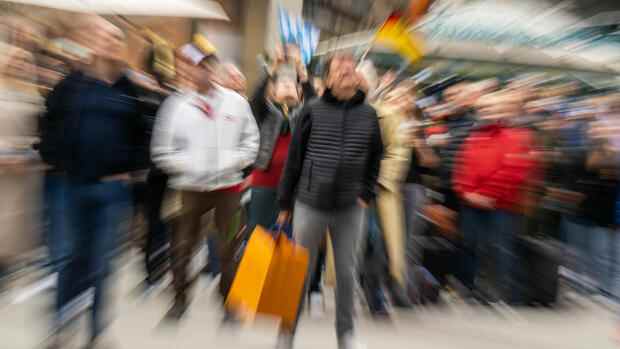The worries caused by the war and the pandemic have diminished – even if many citizens are still cautious about making large purchases.
(Photo: dpa)
Dusseldorf The mood of German consumers apparently improved slightly for the first time in November. This is shown by the latest data from the HDE consumption barometer. After the measured value had previously fallen to the worst value of all time, it is now a good point to go up again – to 85.2 points. The barometer is calculated once a month by the Handelsblatt Research Institute exclusively for the German Retail Association (HDE) and is based on a survey of around 1,600 households.
The index, which had always fluctuated around the value of 100 in the past, had temporarily collapsed in the early days of the corona pandemic. In the wake of the Russian invasion of Ukraine and the resulting energy and inflation crisis, it fell to unprecedented depths.
It is true that all partial values of the barometer are still deep in the red: the respondents continue to shy away from major purchases, expect falling incomes and sharply rising prices. But they don’t do this as much as they did in October. The respondents are only more pessimistic than before when it comes to future interest rate developments: Here they expect a further increase, which would at least make purchases financed by credit even more expensive.
Other statistics also confirm the trend
Small increases in the consumption barometer are not sufficient to be able to announce a trend reversal for the economy. Nevertheless, other statistics recently indicated that the bottom could be over – such as the mood indicators for companies.
Top jobs of the day
Find the best jobs now and
be notified by email.
The Munich-based Ifo Institute recently reported that the business climate index had fallen again. However, only the assessment of the current situation deteriorated, while expectations for the future improved slightly. The same phenomenon was evident in the economic index of the Mannheim ZEW.
>> Read here: Backlog of orders, euro exchange rate, government housing construction: these are the bright spots for the economy
Most economic experts are currently assuming that private consumption will shrink in 2023 – and that economic growth will fall into the red. This means that economic output would remain roughly at the level of 2019.
If the gross domestic product had continued to grow since then, as forecast at the time, it could have been around 200 billion euros higher by 2023 than is currently expected. However, the robust labor market remains a ray of hope: economic researchers are currently assuming that the unemployment rate will at best rise slightly in 2023 – despite the weak economy.
More: Retail reports a surprising increase in sales – petrol stations with a large minus.

